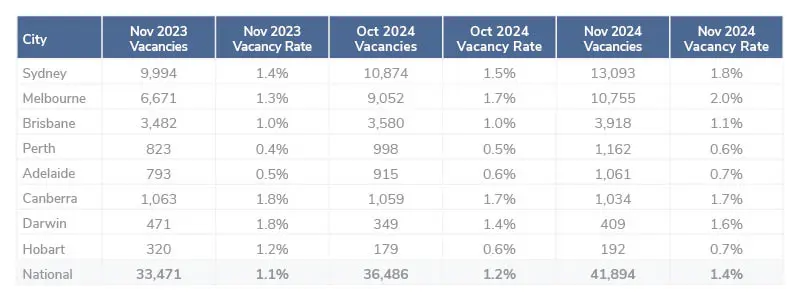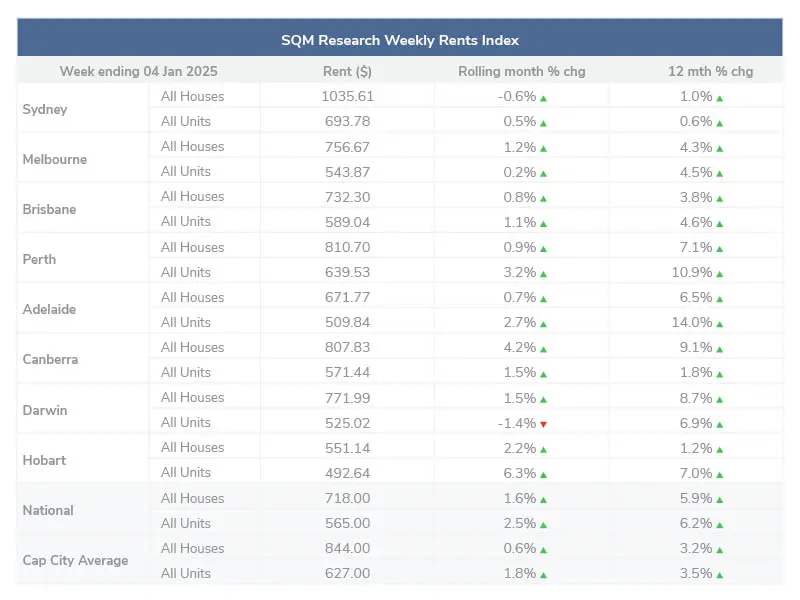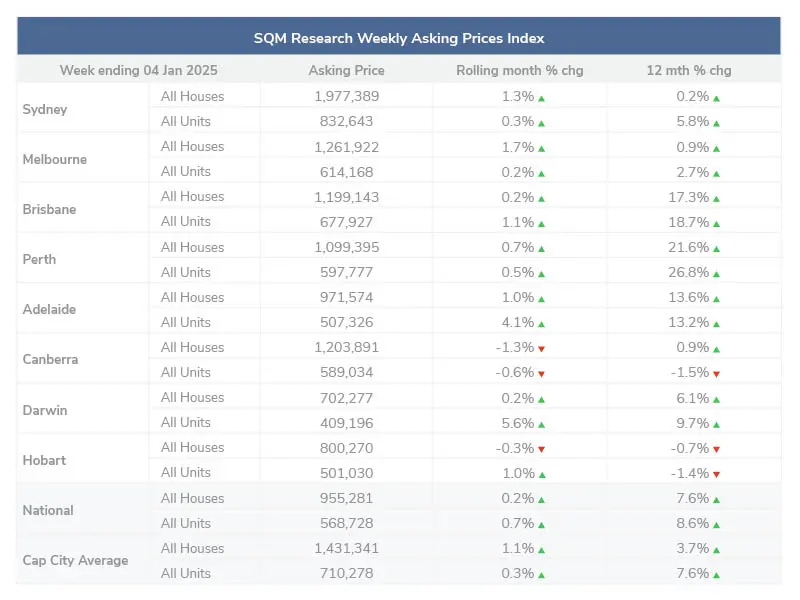December property market update (2024)
- Posted By Nikki Montaser
Vacancy rates increased to 1.4% in November with a marginal change to asking rents. Sales asking prices also experienced marginal movement, with an increase in overall, old and distressed listings, contrasted by a seasonal decrease in new listings.
Vacancy rates
In December 2024, SQM Research reported a slight increase in Australia’s national residential vacancy rate to 1.4%, with rental vacancies increasing to 41,894 properties in November from 36,846 in October. City-specific trends mirrored this national increase to varying degrees.
See a city-specific breakdown below:
- Sydney: Climbed to 1.8%, vacancy rates were indicative of seasonal changes
- Melbourne: Also increased, reaching 2.0%, representing 10,755 vacancy dwellings
- Brisbane: The capital of the Sunshine State saw a conservative rise to 1.1%
- Canberra: Maintained one of the highest vacancy rates at 1.7%
- Perth: In 2024 the capital of the West Coast saw strong demand, this remained true in December with a vacancy rate of 0.6%
- Darwin, Adelaide and Hobart: All saw seasonal lulls with rates rising to 0.7% and 0.6%
Louis Christopher, Managing Director of SQM Research said, “National rental vacancy rates have hit a three-year high with the vacancy rate reaching 1.4%. Now at this time of year, we normally record a seasonal increase in vacancies driven in part by university graduates completing their courses for the year and returning home and so the rise is in part due to seasonality. But there are also other factors that drove vacancies higher in November.
“Melbourne for example has risen back to 2% which is getting close to a market in equilibrium. Sydney is now back at 1.8%. While we still have rental shortages in our two largest capital cities, the situation has clearly improved from the very difficult days of 2021 to 2023. I think this is mainly due to the number of occupiers increasing per property. Sky high rents have forced many to make compromises in their living arrangements.
“Are we out of the rental crisis? No, not yet but there is a little bit of light at the end of the tunnel, notwithstanding another year of rapidly expanding population compared to our low building rate will keep the pressure on tenants in 2025.”

Rental values
Over the past 30 days to 7 January 2025, the national median asking rents for houses increased by 1.6% and 2.5%, changing from last month’s decreases. Across capital cities averages, the median asking rent increased more significantly than the previous few months at 3.2% for houses and 3.5% for units.
Melbourne, Brisbane, Perth, Adelaide, Canberra and Hobart all saw increases in rental values. Sydney and Darwin both experienced varied results.
The largest variation in values over the last year was seen in Adelaide and Perth. Adelaide saw a 14% rolling increase in unit rental values. Perth followed suit with an increase of 10.9% for units, from this time last year.
The average national rental asking price on 4 January 2025 was $718 for houses and $627 for units. Compared to last year, the national rental asking prices increased by 5.9% for houses and 6.2% for units.
The capital city’s average rental asking price on 4 January 2025 was $844 for houses and $627 for units. Compared to last year capital city asking prices increased by 3.2% for houses and 3.5% for units.

Property prices
According to SQM Research’s data collected on 7 January 2025, the Australian property market exhibited the following key trends:
Mixed trends for asking prices
Nationally asking prices across the month of December increased by 0.2% for houses and 0.7% for units. Similarly, capital city asking prices increased by 1.1% for houses and 0.3% for units.
This trend reflects varying market dynamics across different cities, with some areas experiencing more significant price increases than others. Sydney, Melbourne, Brisbane, Perth, Adelaide and Darwin experienced increases in both houses and units. Hobart saw mixed results across houses and units. Canberra experienced decreases in both houses and units.
At 7 Jan 2025 the national asking price for houses was $955,281 and for units was $568,728. The capital city average asking price for houses was $1,431,341 for houses and $710,278 for units.
Additional insights include:
An increase in total property listings nationally by 7.6% in November 2024, reaching 272,645 properties was experienced. Perth led this increase with a 20.0% rise, Darwin was the only city to see a decrease, with listings down by 2.7%.
A seasonal decrease in new property listings (less than 30 days) by 0.4% nationally, totaling 82,138 properties was experienced. Adelaide recorded the largest monthly increase at 12.2%, Darwin, however, experienced a dramatic decline of 20.9% in new listings.
An increase in older listings nationally, as properties listed for over 180 days increased by 6.4% from the previous month, totaling 74,119 properties was experienced. Sydney saw the most significant increases at 11.1%, while Adelaide experienced a decrease of 4.9%.
An increase in distressed listings was experienced. The number of residential properties sold under distressed conditions rose by 1.7% to 5,444. The ACT saw a dramatic increase of 33.3%, whilst the Northern Territory experienced a decrease of 12.2%.
Louis Christopher, Managing Director of SQM Research said, “As predicted, this year’s spring selling season recorded higher listings activity than 2023 with total listings up by 4.6% compared to Spring 2023. However, this was mainly driven by a rise in older listings. New listings were just up by 1.8% to 242,218 new listings for the period. This will be slightly disappointing news to many real estate agents who were counting on a stronger selling season than what has actually happened.
“Clearly the housing market has slowed down, particularly in Sydney and Melbourne where we are recording lower vendor confidence as measured by our asking prices index which fell a further 0.9% for Sydney and 0.7% for Melbourne.
“Going forward, new listings are very likely to fall away in the lead up to Christmas with the typical hiatus period occurring between the 23rd of December through to Australia Day. The first major auction weekend will likely be the 1st of February. However, we should note that summer holiday locations such as the Gold Coast tend to have their busiest period of the year in January and this coming January will be no exception to that tradition.”

Cash rate and predictions
The RBA did meet in December. On 11 December 2024, the RBA held the cash rate target at 4.35% stating, “Inflation has fallen substantially since the peak in 2022, as higher interest rates have been working to bring aggregate demand and supply closer towards balance. Measures of underlying inflation are around 3½ percent, which is still some way from the 2.5 percent midpoint of the inflation target.”
Disclaimer: The information enclosed has been sourced from SQM Research and Reserve Bank of Australia, and is provided for general information only. It should not be taken as constituting professional advice.
PropertyMe is not a financial adviser. You should consider seeking independent legal, financial, taxation, or other advice to check how the information relates to your unique circumstances.
We link to external sites for your convenience. We are selective about which external sites we link to, but we do not endorse external sites. When following links to other websites, we encourage you to examine the copyright, privacy, and disclaimer notices on those websites.
Article posted by Property Me.

